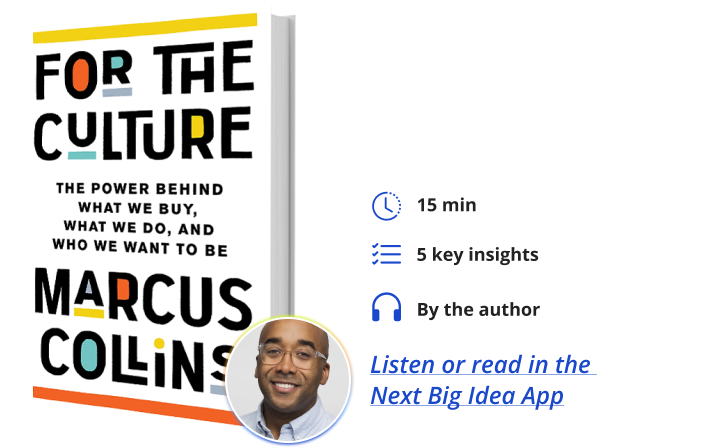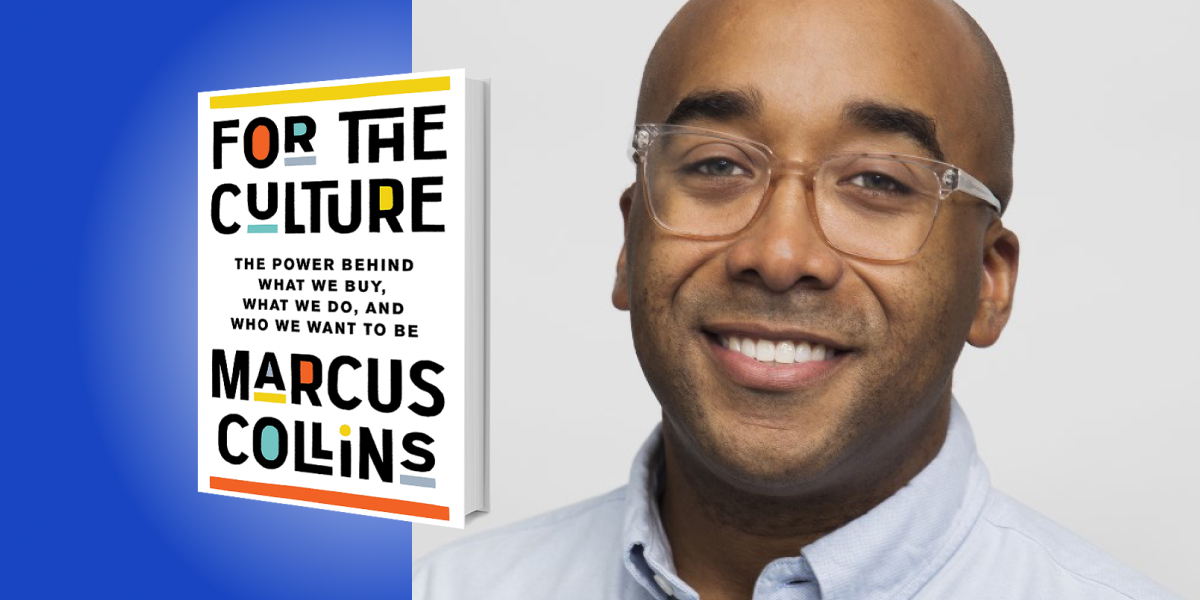Marcus Collins is an award-winning marketer and cultural translator. He is a marketing professor at the Ross School of Business, University of Michigan. He also serves as the Chief Strategy Officer at Wieden+Kennedy New York, a media agency.
Below, Marcus shares five key insights from his new book, For the Culture: The Power Behind What We Buy, What We Do, and Who We Want to Be. Listen to the audio version—read by Marcus himself—in the Next Big Idea App.

1. There’s no force more influential on human behavior than culture.
If you ask five people to define culture, you will get 15 different answers—and that’s a problem. Without a concrete definition to describe culture, we limit our ability to operationalize its sway in our work and day-to-day lives.
The term “culture” finds a home in a broad array of literature, but tends to cumulate as a system of symbols, beliefs, and values from which a group of people and their corresponding roles and norms are established and governed. Through this lens, culture consists of four distinct yet interrelated characteristics: beliefs, artifacts, behaviors, and language. The alchemy of these characteristics represents one’s culture.
We see it demonstrated in our ethnicities, nationalities, religions, and passions. For instance, if you subscribe to sneaker culture, then there are beliefs, artifacts, behaviors, and language that are expected of you to be counted among the community of sneakerheads. Whether you’re into skating, gaming, collecting comics, or performing cosplay, each of these collectives has cultural characteristics that are normalized within the community and expected of those who self-identify as such. Therefore, those who see themselves as a member of the community subsequently adhere to these norms to promote social solidarity and remain in lockstep with its members.
Consumption, by its very nature, is a cultural act. What we buy, wear, drive, how we style our hair, where we go to school, who we marry, if we marry, where we vacation, and how we bury the dead are all byproducts of cultural subscriptions.
Culture moves forward based on one simple question: do people like me do something like this? If the answer is yes, we do it. If the answer is no, we don’t. Therefore, if you have a vested interest in getting people to take action, then culture is your biggest cheat code.
2. The future of brands will be communal.
The earliest established brand was founded in the 1700s by Josiah Wedgewood, a potter. To ensure that his pottery was not confused with other product offerings, he put his name on it and trademarked the name to signify ownership. This was how brand marketing was done in those days. You put a label on your commodity and it served as a legal mark.
Fast-forward two and a half centuries later to the 1950s, marketers got the bright idea that we could convince more people to buy by using psychology. So, marketers adopted value propositions, positioning statements, and cognitive associations to create familiarity and instill trust. In this way, brands moved beyond being legal marks to become trust marks.
“Brands will transcend to become tribal marks where people within the community share a similar worldview and abide by the same cultural conventions and expectations.”
By the 1980s, marketers grew tired of transactional relationships with consumers. They wanted to be loved by consumers. So, they used advertising to tell evocative narratives where the brand played a character in their stories. This moved the brand from a trust mark to a love mark.
Today’s most powerful brands leverage culture to connect with people’s sense of identity, such that the brand expresses who its consumers are to the world. These brands have evolved beyond love marks to become identity marks.
Tomorrow’s brands will be about community. Aristotle said it best: man, by nature, is a social animal. We are tribal, given to gathering and communing in familiar groups. We want to belong. As we use brands to say something about ourselves, we find people who are like us, thus forming communities. In this way, brands will transcend to become tribal marks where people within the community share a similar worldview and abide by the same cultural conventions and expectations. Today’s technology facilities this evolution through its decentralized networks, like WEB 3.0 and greater media fragmentation. The brands that facilitate these communities will win, while the ones that remain focused on value propositions will lose.
3. Our approach to market segmentation needs an upgrade.
Marketers typically reply on demographics to describe people based on their age, race, gender, household income, geography, and education. Demographics provide discrete boxes to categorize people and make the world neat. But demographics, while factual, don’t accurately describe who people are.
Take my demographics, for example. I am an African American man. I’m forty-four years old. I’m from Detroit, Michigan—born and raised—and I went to public schools my entire life. If a marketer saw this description of me, they would likely put me in a box based on stereotypes about what forty-something Black men who live in Detroit do. Or, if I told you that “Deborah drives a minivan,” then you’d likely think she probably has kids who play soccer and they probably live in a suburb.
“Demographics never get close enough to capture the nuances that make me who I truly am.”
These depictions aren’t true, but they are easy. We rely on cognitive shortcuts all the time. We say things like all women love to shop. I am forty-four years old, Black, from Detroit, and attended public schools my entire life, but none of this gets at the fact that I grew up playing jazz or that I swam competitively from age six through high school. I wrote love songs for a living in my twenties and listened to the Monkees as much as A Tribe Called Quest. These experiences helped shape how I see the world, which ultimately formed how I behave in the world.
Demographics never get close enough to capture the nuances that make me who I truly am. However, my tribal communities do, which makes these networked groups a better means of segmenting the market than demographics. Demographics do a terrible job of describing real people; cultural communities are far more accurate and predictable.
4. The world is culturally constructed.
Things aren’t the way they are, they are the way we are. Reality is subjective and meaning is not fixed. Take for instance the color red. Red is a color, but what does it mean? It has no inherent meaning. However, at a red light at an intersection, red means stop. We collectively agreed that red means stop, just as green means go. But red also means passion. It also means danger. And it also means hot, angry, and sexy. Red has many different meanings, but none of them are inherent to the word. These are the meanings that we, as a society, have constructed.
Ferdinand de Saussure, one of the fathers of semiotics, once said that everything around us is inherently meaningless. Look around you. Everything your eye can see at this very moment has no intrinsic meaning. Instead, we collectively negotiate and decide meaning. That’s why for some people a cow is leather. For some it’s dinner. And for others, it’s a deity. Which one is true? All of them, because meaning is not fixed. Meaning is culturally mediated based on how we see the world. Understanding how people make meaning will increase the likelihood of understanding who they are and how they navigate the world.
5. We mistake information for intimacy.
We live in a hyper-connected world where there is more data collected than ever before. Every Google search, credit card swipe, and authored tweet leaves a breadcrumb of information that amounts to reams of data. Though the amount of data available to marketers has increased exponentially, our ability to extract insight from said data has only marginally increased. This paradox amounts to a simple—yet significant—oversight: we mistake information for
intimacy.
“To understand who people are, you must get intimate.”
Before an important meeting, you likely go to LinkedIn to learn about the person you’ll be speaking with. However, you don’t get to know the person until you’ve interacted with them, exchanged ideas, or observed their mannerisms. These details are only revealed once you’ve moved beyond the statical details.
To know people requires intimacy, a closeness that traditional data metrics will never provide. We know this intuitively. However, when we get in the boardroom, we take off our “human hat” in exchange for our “marketing hat,” leaving our humanity at the door. It’s time that we became more human. Site traffic, engagement across social networking platforms, purchases, and search queries can reveal a consumer’s interests, preferences, and desires. Yet, despite having this information, marketers still struggle to understand their consumers because those metrics are not who people are—they are merely what people do. To understand who people are, you must get intimate.
To listen to the audio version read by author Marcus Collins, download the Next Big Idea App today:
































